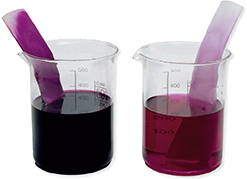Quick Lab
Observing the Action of Catalysts
Materials
5 test tubes, test-tube rack, marking pencil, dropper pipet, wood splint, platinum wire, 0.1 g manganese dioxide (MnO2), 5 drops of copper(II) chloride (CuCl2) solution, 0.1 g raw potato, graduated cylinder, 25 mL hydrogen peroxide (H2O2)
Procedure 
Label the 5 test tubes from A to E with the marking pencil.
Put a small piece of platinum wire in test tube A. Add a tiny amount (about the tip of the wood splint) of MnO2 to test tube B. Use the dropper pipet to put 5 drops of CuCl2 in test tube C. Put a piece of potato in test tube D. Test tube E should remain empty for now. CAUTION MnO2 and CuCl2 are toxic.
Carefully add 5 mL of hydrogen peroxide to test tube A. CAUTION Be careful when using chemicals. Observe how fast the bubbles are produced.
Repeat Step 3 with test tubes B through E.
Analyze and Conclude
Observing What effect did the platinum wire, MnO2, CuCl2, and the potato have on the rate at which the bubbles were produced in the hydrogen peroxide?
Comparing and Contrasting Which catalyst(s) caused the reaction to go the fastest? The slowest?
Inferring Why did you put only hydrogen peroxide in test tube E?
Figure 22 The dye solution in the left beaker is more concentrated than the solution in the right. Increasing the concentration of the dye increases the rate of color change in the material.

Stirring
You can also increase the exposure of reactants to each other by stirring them. For example, when you wash your clothes in a washing machine, particles of detergent react with particles of the stains on your clothes. This reaction would go slowly if you just left your clothes soaking in a tub of water and detergent. A washing machine speeds up the reaction by stirring the contents back and forth. Collisions between the particles of the reactants are more likely to happen. Stirring the reactants will generally increase the reaction rate.
Concentration
Another way you can change the reaction rate is to change the concentration of the reactants. Concentration refers to the number of particles in a given volume. The more reacting particles that are present in a given volume, the more opportunities there are for collisions involving those particles. The reaction rate is faster.
Both of the beakers in Figure 22 contain a piece of material dipped in dye solution. Dyeing is a chemical reaction in which dye particles react with the particles of the material being dyed. The material dipped in the more concentrated dye becomes colored more quickly.
For gases, concentration changes with pressure. The greater the pressure of a gaseous reactant, the greater is its concentration, and the faster is the reaction rate.




